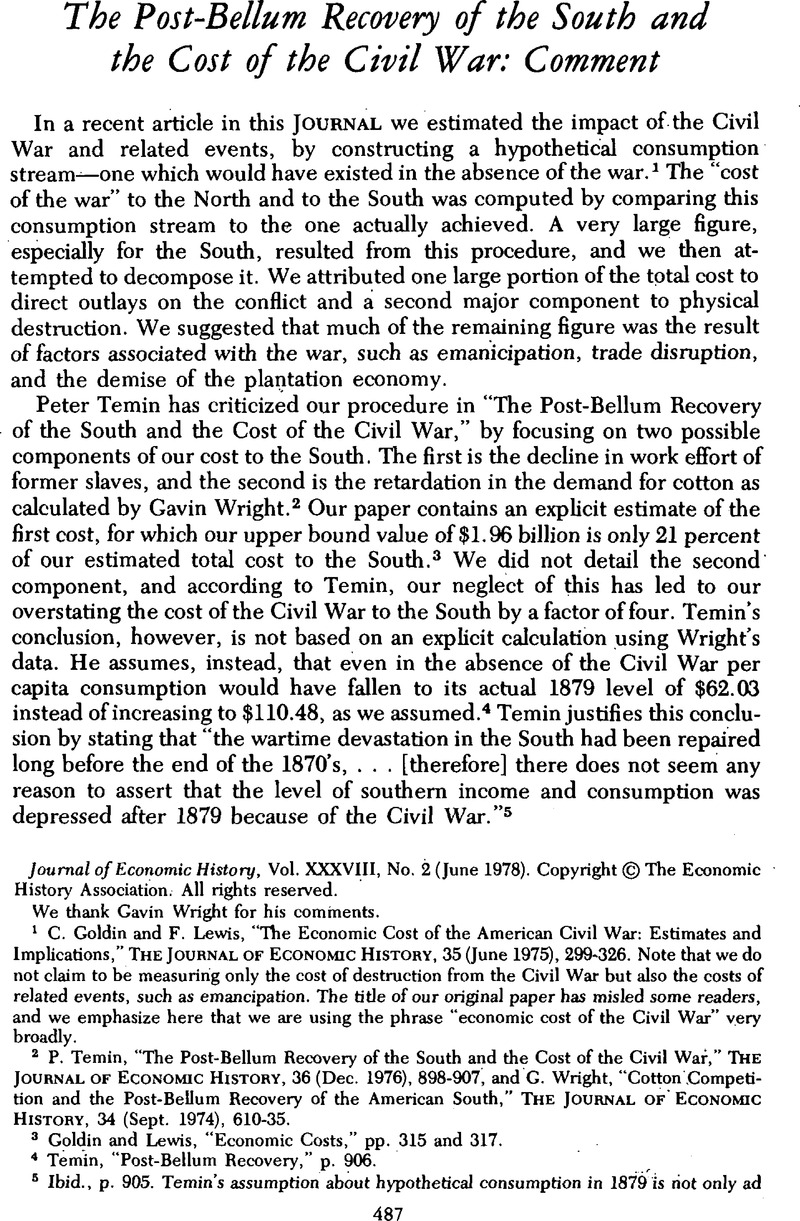Published online by Cambridge University Press: 11 May 2010

1 Goldin, C. and Lewis, F., “The Economic Cost of the American Civil War: Estimates and Implications,” The Journal of Economic History, 35 (June 1975), 299–326CrossRefGoogle Scholar. Note that we do not claim to be measuring only the cost of destruction from the Civil War but also the costs of related events, such as emancipation. The title of our original paper has misled some readers, and we emphasize here that we are using the phrase “economic cost of the Civil War” very broadly.
2 Temin, P., “The Post-Bellum Recovery of the South and the Cost of the Civil War,” The Journal of Economic History, 36 (Dec. 1976), 898–907CrossRefGoogle Scholar, and Wright, G., “Cotton Competition and the Post-Bellum Recovery of the American South,” The Journal of Economic History, 34 (Sept. 1974), 610–35CrossRefGoogle Scholar.
3 Goldin and Lewis, “Economic Costs,” pp. 315 and 317.
4 Temin, “Post-Bellum Recovery,” p. 906.
5 Ibid., p. 905. Temin's assumption about hypothetical consumption in 1879 is not only ad hoc but is also contradicted by some facts about the capital stock. In 1860 the (non-slave) capital stock was $3.485 billion, that is $399 per capita. Our estimate for 1870 is $2.477 billion and the 1880 Federal Census gives a value for the capital stock of $4.506 billion or $346 per capita. The 1880 per capita figure is 13 percent less than that for 1860 and far less than a hypothetical value which assumes the capital stock would have continued to grow at its prewar rate. (See Goldin and Lewis, “Economic Cost,” accompanying “Notes,” pp. xvii-xix. All values are expressed in 1860 dollars.)
6 Gallman, Robert, “Commodity Output, 1839–1899,” in National Bureau of Economic Research, Trends in the American Economy in the Nineteenth Century, Studies in Income and Wealth, vol. 24 (Princeton, 1960), pp. 43 and 46. All values are in 1860 dollarsGoogle Scholar.
7 The prewar demand curve estimated by Wright is:
(Wright, “Cotton Competition,” p. 631, Table 7, assumption 1). Between 1859 and 1879 cotton output increased by 21.4 percent and its relative price increased by 6.5 percent (Gallman, “Commodity Output, 1839–1899,” pp. 43, 46 and 47). By applying Wright's estimate of the elasticity of cotton demand, −1.099, we derive an actual increase in the level of cotton demand of 30 percent over this period. However, if one extrapolates the prewar demand curve forward for 20 years, (at 5.4 percent per year) one gets a hypothetical level of demand in 1879 which is 186 percent greater than the 1859 level. Therefore the actual level of demand in 1879 was only 45 percent of its hypothetical value. This same calculation in per capita terms results in a larger figure because the rate of population growth in the South fell after 1859. Note that converting demand curve shifts to per capita terms changes only slightly the relationship between actual and hypothetical demand. In no way does this conversion imply a dependence of cotton demand on southern population growth. Furthermore, the per capita value, 49 percent, is appropriate for our purpose since in our original article the hypothetical consumption stream was based on per capita prewar growth rates.
8 This equation is derived by integrating over the supply curve. For a similar derivation see Goldin, and Lewis, , “The Role of Exports in American Economic Growth during the Napoleonic Wars, 1793 to 1807,” in Caves, R., North, D., and Price, J., editors, Exports and Growth in Economic History (Princeton: Princeton University Press, forthcoming)Google Scholar.
9 For example, if we assume that both the value of cotton and non-cotton outputs had each continued to grow at their per capita prewar rates, then per capita consumption would have increased at 1.62 percent per year, not at 1.30 percent per year as we have assumed in our paper. Per capita consumption in 1879 would then have been $117.40. Reducing this figure by the effect of the slowdown in cotton demand from Wright's data gives the following results:

10 Note that this does not imply that the retardation in the demand for cotton was caused by the Civil War. This is merely a convenient way of allocating our original measure, the indirect cost of the war. These four factors, related or not to the war, all resulted in lower per capita consumption.